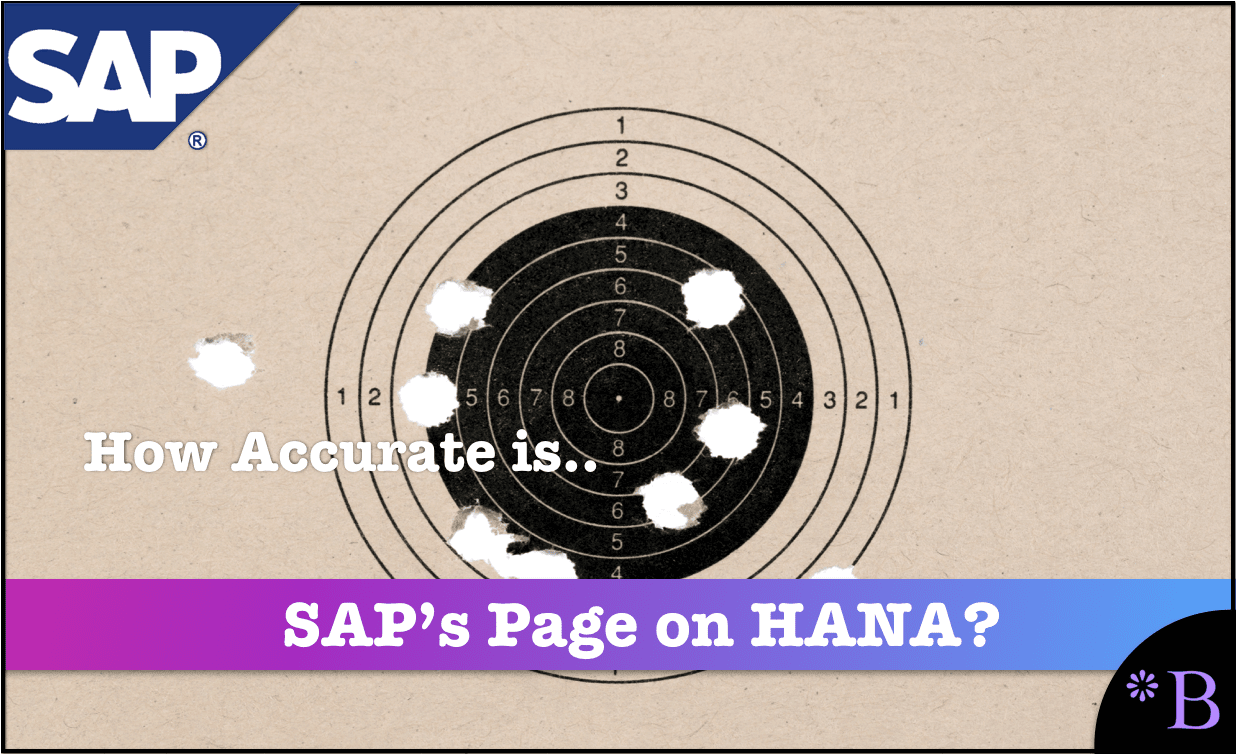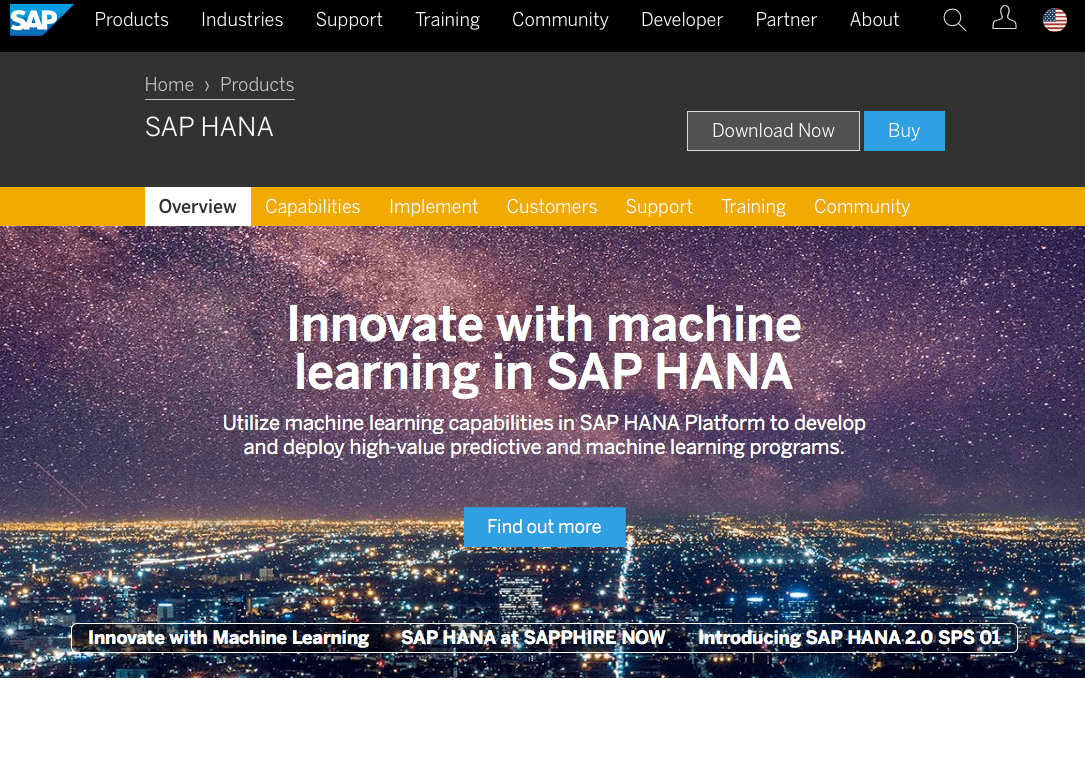How Accurate is SAP’s Page on HANA?
Executive Summary
- SAP has a page on HANA, which makes some “interesting” claims.
- We evaluate the accuracy of this page.

Introduction
In this article, we will review SAP’s HANA page and check it for accuracy.
Our References for This Article
If you want to see our references for this article and other related Brightwork articles, see this link.
Notice of Lack of Financial Bias: We have no financial ties to SAP or any other entity mentioned in this article.
 Quotes from the SAP’s Main HANA Page
Quotes from the SAP’s Main HANA Page
What is HANA?
Deployable on premise or in the cloud, SAP HANA is an in-memory data platform that lets you accelerate business processes, deliver more business intelligence, and simplify your IT environment. By providing the foundation for all your data needs, SAP HANA removes the burden of maintaining separate legacy systems and siloed data, so you can run live and make better business decisions in the new digital economy.
Almost all HANA instances are on-premises. So while SAP often presents the idea of such a broad choice among its offerings, customers are not choosing to use the cloud option SAP’s non-acquired offerings.
It is not at all clear that HANA simplifies the IT environment. The proposal is that all applications can reside on a single HANA instance. However, even if this were desirable and feasible, HANA is too expensive to manage this way. HANA is the most expensive database in the market (at Brightwork, we maintain the ability to price HANA accurately, unlike how SAP will price HANA using some inaccurate assumptions. Part of this is covered in the article The Secret to Not Talk About HANA Pricing.) But even if HANA were lower price, it still would not necessarily make the IT environment more simple. In fact, the change-over from the current databases being used adds complexity to the IT environment. And information from HANA implementations is that HANA has a lot more maintenance costs than competing databases.
SAP said this also about their ERP system in the 1980s, and none of those predictions came true. The concept was that SAP’s ERP system would eliminate the need for all legacy systems, as is covered in the article How SAP Used and Abused the Term Legacy.
Key Benefits of HANA
Reduce Complexity
Simplify IT with ONE platform for trans-analytic applications. Use SAP HANA to analyze live data to support real-time business, while reducing data redundancy, footprint, hardware, and IT operations.
No, there is no evidence of this occurring. There are no case studies where customers have moved most of their applications to HANA. Secondly, HANA is a single purpose database. It is designed for analytics. AWS, a PaaS that provides many databases, does not offer HANA type databases for all applications. Rather they offer specific databases for specialized applications. Transactions, Analytics, Big Data are not optimally served from the same database type.

Run Anywhere
Modernize your data center with flexible SAP HANA deployment options – public or private
cloud, tailored data center, or 1000+ certified appliance configurations from 13 leading vendors.
HANA is, in almost all instances, deployed as an on-premises delivery model. SAP has many options, but those options are not particularly relevant because they are not exercised but customers.
Real Results
Achieve better business outcomes with SAP HANA. Learn how companies are seeing 575% five-year ROI by using SAP HANA to increase innovation, while decreasing data management costs.
SAP has never provided actual evidence for any ROI claims. HANA is the most expensive database that one can purchase, so having this type of eye-popping ROI on such an expensive database would be peculiar.
Key Capabilities of SAP HANA
SAP HANA transforms database management. It processes transactions and analytics in-memory on a single data copy – to deliver real-time insights from live data. And simplify operations with modern tools and a secure, rock-solid foundation.
Actually, evidence from the field indicates that HANA has performance issues with transactions, which is most of what any ERP database does. SAP stopped performing the transaction processing benchmark, as is covered in the article, What is the Actual Performance of HANA?
SAP HANA transforms data management. Access quality data wherever it best resides using data virtualization, integration or replication. Manage data across multi-tier storage to achieve best performance and total cost of ownership.
SAP has no studies that show that HANA provides a better TCO. Forrester produced a study sponsored by SAP that stated that HANA might reduce TCO. Still, it was not based on any evidence of actual HANA implementations. It is considered by Brightwork to be an illegitimate study.
SAP HANA transforms analytic intelligence. Use advanced data processing for business, text, spatial, graph, and series data in one system to gain unprecedented insight. And deliver deeper insights using powerful machine learning and predictive analytics capabilities.
This is again unproven by SAP. Transforms is a significant word that SAP uses quite frequently, but it does not provide evidence. SAP is frequently using the term digital transformation, which is illogical for most IT implementations, as is covered in the article The Problem with Using the Term Digital Transformation for Modern IT Projects.
Simplify application development with in-memory computing
IT and software development professionals view in-memory computing as a viable option to increase simplicity and real-time performance. Discover how in-memory computing can spur the creation of custom-built applications to meet distinctive needs and enable integration across the enterprise.
SAP seems to be commingling several concepts here. They include the following:
- Simplicity
- Real-time performance
- In-memory computing
- Custom build applications,
- Integration across the enterprise
However, the only terms that have anything to do with HANA are real-time performance and in-memory computing. The rest is simply being added willy-nilly to the sentence. This is a common tactic by Hasso Plattner, which is to throw so many terms at the reader that they become overwhelmed.
SAP S/4HANA
Built on SAP HANA, SAP S/4HANA is a next-generation business suite designed to help customers thrive in the digital era. Digitize and simplify your processes – and provide a personalized user experience with the SAP Fiori UX.
SAP’s accuracy on S/4HANA is covered in the following article.
SAP Vora
SAP Vora is an in-memory, massively distributed data processing engine that allows you to analyze Big Data stored in Hadoop. Use it to gain real-time, relevant insights that support faster and more informed decisions.
- Process and analyze Big Data in Hadoop
- Correlate Hadoop and SAP HANA data
- Organize massive volumes of unstructured data
This will be covered in a future article dedicated to Vora.
SAP BW/4HANA
SAP BW/4HANA is an integrated data warehouse solution optimized to fully leverage the SAP HANA in-memory platform. SAP BW/4HANA dramatically simplifies development, administration and user interface of your data warehouse resulting in enhanced business agility.
- Simplify your data warehouse architecture
- Integrate SAP and non-SAP apps and data into one logical data warehouse
- Built for on-premise and the cloud
This will be covered in a future article dedicated to SAP BW/4HANA.
Conclusion
SAP really pulled out all the stops to falsify information for this article.
This SAP article has a Brightwork Accuracy Score of 2 out of 10.